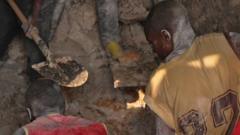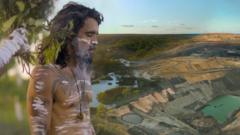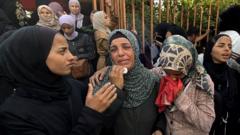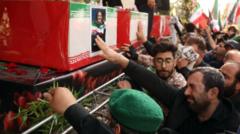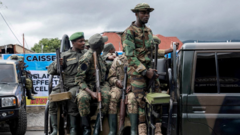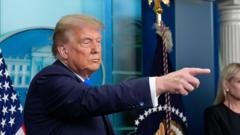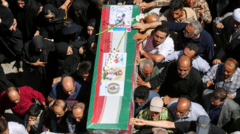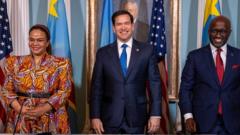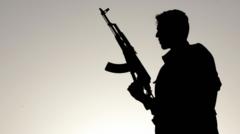The Rubaya mine, rich in coltan ore, remains a crucial player in the global mobile phone supply chain, offering a glimpse into the lives of miners amid ongoing tensions in the Democratic Republic of Congo.
Rebels Grant Rare Access to Coltan Mine in Eastern DR Congo Vital for Mobile Phones
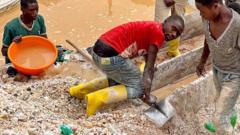
Rebels Grant Rare Access to Coltan Mine in Eastern DR Congo Vital for Mobile Phones
M23 Rebels Provide Insight into the Operations of the Rubaya Mine Amid Ongoing Conflict
The article text:
In a remarkable turn of events, M23 rebels in eastern Democratic Republic of Congo have granted the BBC direct access to the Rubaya mining site, a major source for coltan, a mineral essential for mobile phone production. With over 10,000 miners reportedly working daily, the landscape is bustling with individuals engaged in various stages of the mining process, from digging and hoisting ore to washing and filtering it.
Patrice Musafiri, the mine's supervisor, emphasized the necessity of the mine for local families, asserting that it provides a vital source of income. For many, including mineworker Peter Osiasi, mining is a livelihood, despite its arduous nature and the dangers associated with working in high temperatures and possible harmful gases. Osiasi shared, "My life has really changed. Mining has really helped me," citing his ability to support his family through his earnings.
The Rubaya mine is located in the lush Masisi Hills, approximately 60 kilometers north-west of Goma, and is known to hold 15% of the world’s coltan supply. This region, with its historical turmoil, has attracted global investors keen on unlocking its mineral wealth. The mine functions under the supervision of the M23, which has claimed to bring security to the site, where armed men are prohibited.
Recent geopolitical developments have intriguing implications for the mine and surrounding area. Following a ceasefire agreement in Washington aimed at stabilizing the region, the M23 remains in control of significant portions of eastern DR Congo. While various groups vie for influence, the complexity of the local dynamics is compounded by the ethnic conflicts at play, particularly involving the Hutu militia and the ongoing tensions with Rwanda.
During the visit, Musafiri highlighted strides towards better organization within the mine, including safety regulations and internal conflict resolution mechanisms. However, miners have expressed concerns about their earnings, which remain disappointingly low despite the apparent economic activity surrounding them.
The United States has shown interest in developing the DR Congo's mineral resources, a strategy closely linked to its broader foreign policy initiatives in the region. With U.S. firms reportedly eyeing potential investments in the Rubaya mining sector, local leaders stress the need for investments that would directly benefit the community.
While American companies could bring infrastructural improvements to mining communities, the rebels' control over the area introduces uncertainties into investment processes. Analysts suggest that a strong U.S. presence could deter further conflict, as local miners continue to call for improved wages and stable working conditions in the face of enduring volatility.
In the midst of these challenging conditions, the miners at Rubaya and beyond remain hopeful for a peaceful resolution to the conflicts that have plagued their homeland, with young worker Osiasi's appeal to maintain peace resonating amidst the turmoil. As recovery and development efforts unfold, the world watches closely, not just for the resources extracted from the earth but for the lives impacted by this multi-layered struggle.
In a remarkable turn of events, M23 rebels in eastern Democratic Republic of Congo have granted the BBC direct access to the Rubaya mining site, a major source for coltan, a mineral essential for mobile phone production. With over 10,000 miners reportedly working daily, the landscape is bustling with individuals engaged in various stages of the mining process, from digging and hoisting ore to washing and filtering it.
Patrice Musafiri, the mine's supervisor, emphasized the necessity of the mine for local families, asserting that it provides a vital source of income. For many, including mineworker Peter Osiasi, mining is a livelihood, despite its arduous nature and the dangers associated with working in high temperatures and possible harmful gases. Osiasi shared, "My life has really changed. Mining has really helped me," citing his ability to support his family through his earnings.
The Rubaya mine is located in the lush Masisi Hills, approximately 60 kilometers north-west of Goma, and is known to hold 15% of the world’s coltan supply. This region, with its historical turmoil, has attracted global investors keen on unlocking its mineral wealth. The mine functions under the supervision of the M23, which has claimed to bring security to the site, where armed men are prohibited.
Recent geopolitical developments have intriguing implications for the mine and surrounding area. Following a ceasefire agreement in Washington aimed at stabilizing the region, the M23 remains in control of significant portions of eastern DR Congo. While various groups vie for influence, the complexity of the local dynamics is compounded by the ethnic conflicts at play, particularly involving the Hutu militia and the ongoing tensions with Rwanda.
During the visit, Musafiri highlighted strides towards better organization within the mine, including safety regulations and internal conflict resolution mechanisms. However, miners have expressed concerns about their earnings, which remain disappointingly low despite the apparent economic activity surrounding them.
The United States has shown interest in developing the DR Congo's mineral resources, a strategy closely linked to its broader foreign policy initiatives in the region. With U.S. firms reportedly eyeing potential investments in the Rubaya mining sector, local leaders stress the need for investments that would directly benefit the community.
While American companies could bring infrastructural improvements to mining communities, the rebels' control over the area introduces uncertainties into investment processes. Analysts suggest that a strong U.S. presence could deter further conflict, as local miners continue to call for improved wages and stable working conditions in the face of enduring volatility.
In the midst of these challenging conditions, the miners at Rubaya and beyond remain hopeful for a peaceful resolution to the conflicts that have plagued their homeland, with young worker Osiasi's appeal to maintain peace resonating amidst the turmoil. As recovery and development efforts unfold, the world watches closely, not just for the resources extracted from the earth but for the lives impacted by this multi-layered struggle.



